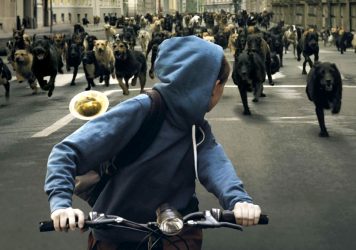Istanbul’s semi-feral dog population is the focus of this thought-provoking ethnographic documentary.
A celebrated director of documentary shorts, Elizabeth Lo makes a compelling leap to features with Stray, a concise ethnographic film that’s presented from a nonhuman perspective. Filmed mostly in Istanbul between 2017 and 2019, with an occasional detour to slightly further afield, the film uses the city’s interesting and complicated history with stray dogs as a means to explore life on the peripheries of human society, free of status and security.
The Turkish state has attempted widespread annihilation of stray dogs since the 1900s, resulting in mass killings of the street dog population. But while campaigns to drive non-pet dogs from towns and cities still gain a little traction now and again, widespread protests against these killings have allowed Turkey to become one of the only countries where it’s currently illegal to euthanise or hold captive any dog without an apparent owner. Meanwhile, dogs that don’t appear to be a human’s property are integrated into the fabric of urban existence with relatively minimal backlash.
Aside from one memorable sequence in which a GoPro is strapped to the back of a canine, Stray was filmed entirely by Lo as she followed a number of street dogs across Istanbul in areas both heavily populated or in disarray due to redevelopment.
An entertaining making-of doc could be assembled had any collaborator happened to film her from afar during its making; crouching while walking to capture the dogs’ natural behaviour in crowded places, including a women’s march protest at one point, particularly so as not to influence the animals’ response in given situations or anthropomorphise them in any way.
Since two years’ worth of trips to Istanbul have been condensed into a 72-minute runtime, it’s likely Lo had at least some footage where she interacted with her dog subjects beyond just trailing them, particularly if some showed resistance to being followed. Her most frequently featured stars are a puppy named Kartal and two older dogs named Nazar and Zeytin, with the latter having the most screen time and acting as the most crucial guide through the streets of Istanbul.
Semblances of a narrative structure or ‘storylines’ are defined by where Zeytin wanders or lingers – getting into standoffs with other stray or domesticated dogs, catching snippets of sociopolitical or romantic conversations from passers-by, or running into some recurring human presences who interact with the dog and its occasional companions with compassion, in contrast to some others.
These presences include construction workers who dish up meals for local strays to feast on, but also, in the most significant plot strand of sorts, a trio of Syrian refugees who’ve been homeless in the city for over a year, who find desperately needed comfort and affection in their repeat encounters with Zeytin, Nazar and Kartal on the otherwise uncaring streets.
The film’s title takes on a dual layer with these young people’s heartbreaking plight, though Lo certainly doesn’t bludgeon home her commentary on either the marginalised or wider perceptions of valid citizenship with her footage as it has been collected and edited.
Published 23 Mar 2021
Dogwoof distributing a dogumentary.
An engrossing and unvarnished document of living on the margins.
A simple but effective sensory voyage that’s hard to shake.

This Orwellian fable which climaxes in the creation of an all-dog army never transcends its central gimmick.